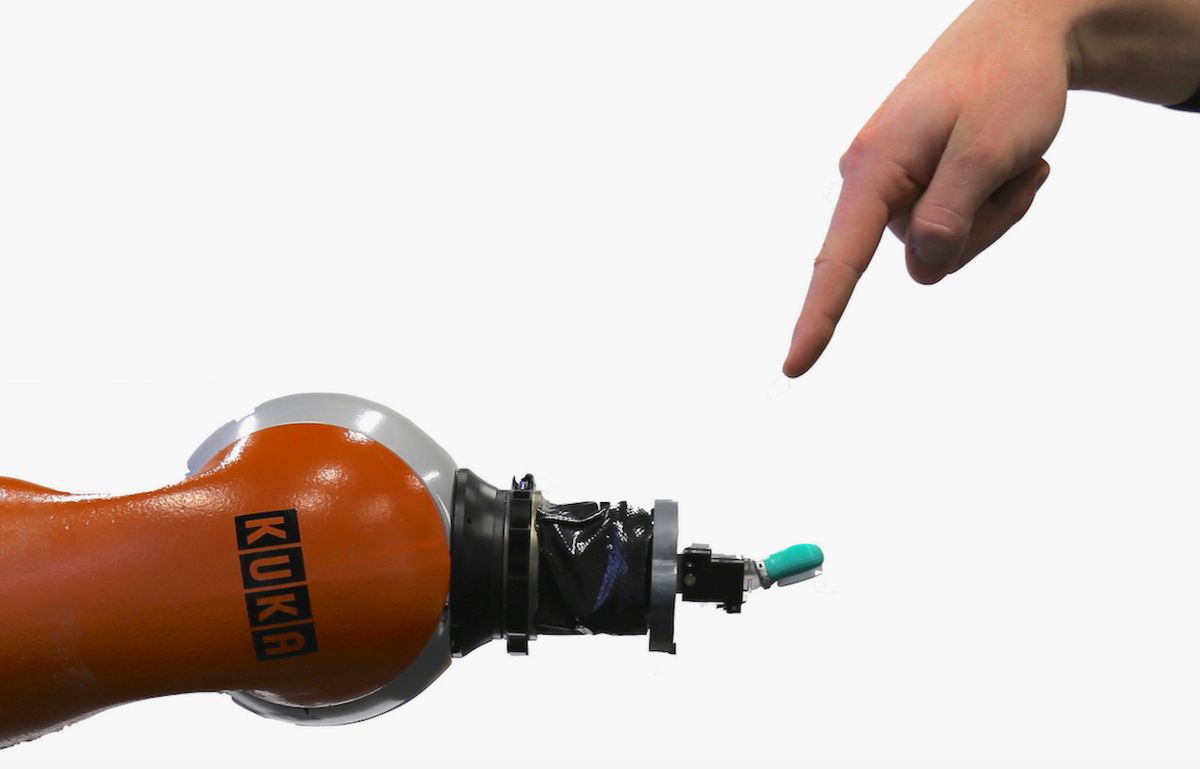One of the most useful things about robots is that they don’t feel pain. Because of this, we have no problem putting them to work in dangerous environments or having them perform tasks that range between slightly unpleasant and definitely fatal to a human. And yet, a pair of German researchers believes that, in some cases, feeling and reacting to pain might be a good capability for robots to have.
The researchers, from Leibniz University of Hannover, are developing an “artificial robot nervous system to teach robots how to feel pain” and quickly respond in order to avoid potential damage to their motors, gears, and electronics. They described the project last week at the IEEE International Conference on Robotics and Automation (ICRA) in Stockholm, Sweden, and we were there to ask them what in the name of Asimov they were thinking when they came up with this concept.
Why is it a good idea for robots to feel pain? The same reason why it’s a good idea for humans to feel pain, said Johannes Kuehn, one of the researchers. “Pain is a system that protects us,” he told us. “When we evade from the source of pain, it helps us not get hurt.” Humans that don’t have the ability to feel pain get injured far more often, because their bodies don’t instinctively react to things that hurt them.
Kuehn, who worked on the project with Professor Sami Haddadin, one of the world’s foremost experts in physical human-robot interaction and safety, argues that by protecting robots from damage, their system will be protecting humans as well. That’s because a growing number of robots will be operating in close proximity to human workers, and undetected damages in robotic equipment can lead to accidents. Kuehn and Haddadin reasoned that, if our biological mechanisms to sense and respond to pain are so effective, why not devise a bio-inspired robot controller that mimics those mechanisms? Such a controller would reflexively react to protect the robot from potentially damaging interactions.
The idea of a reflex controller for robots isn’t a new one. Torsten Kroeger and colleagues at Stanford and the University of Rome–La Sapienza developed one half a decade ago that helped a robot arm avoid collisions with people:
As you can see, this controller does collision avoidance, and it’s very concerned with not running into that human, but not at all concerned with its own safety, except as a byproduct. Indeed, an artificial robot nervous system designed to feel pain and react to it is completely different, and based on how humans deal with painful tactile sensations, as Kuehn and Haddadin write in their ICRA paper:
A robot needs to be able to detect and classify unforeseen physical states and disturbances, rate the potential damage they may cause to it, and initiate appropriate countermeasures, i.e., reflexes. In order to tackle this demanding requirement, the human antetype shall serve as our inspiration, meaning that human pain-reflex movements are used for designing according robot pain sensation models and reaction controls. We focus on the formalization of robot pain, based on insights from human pain research, as an interpretation of tactile sensation.
This video shows a prototype of the controller running on a Kuka arm equipped with a BioTac tactile fingertip sensor (it can sense pressure and also temperature). I find that it helps if you imagine the robot saying “Ouch!” louder and louder each time:
The robot’s tactile system is using a “nervous robot-tissue model that is inspired by the human skin structure” to decide how much pain they should feel for a given amount of force. Just like human neurons, the model transmits pain information in repetitive spikes if the force exceeds a certain threshold, and the pain controller reacts after classifying the information into light, moderate, or severe pain.
In the [light] pain class, such contacts occur that may harm the robot or prevent it from performing the task. The robot “feels” uncomfortable and shall smoothly retract until the contact event is over and return thereafter. Strong collisions are covered in the [moderate] pain class. The robot “feels” moderate pain, shall quickly retract, and more distant until the contact event is over. Then, it may move back. The [severe] pain class covers all contacts in which the robot may be damaged and thus needs some sort of “help”. In order to prevent making the damage worse, the robot switches to gravity compensation with additional damping for dissipation, improving the safety of the robot and the environment by its strictly passive behavior.
In terms of both bio-inspiration and control, this paper is just the first step towards a pain-based reflex controller for robots, but as sinister as it sounds, it’s something that most robots could get a lot of use out of, especially given the overall increase in robot autonomy and collaboration with human workers. Keeping robots from hurting people is certainly a top priority, but even Asimov would agree that keeping robots from hurting themselves is also important if we want to have them around us.
“An Artificial Robot Nervous System to Teach Robots How to Feel Pain and Reflexively React to Potentially Damaging Contacts,” by Johannes Kuehn and Sami Haddadin from Leibniz University in Hannover, was presented last week at ICRA 2016 in Stockholm, Sweden.
Evan Ackerman is a senior editor at IEEE Spectrum. Since 2007, he has written over 6,000 articles on robotics and technology. He has a degree in Martian geology and is excellent at playing bagpipes.



